Tesco Bundle
Who Really Owns Tesco?
Unraveling the complex web of Tesco SWOT Analysis reveals more than just its market position; it exposes the core of its strategic direction and accountability. Understanding "Who owns Tesco" is crucial for any investor or business strategist. The shifts in Tesco shareholders, particularly among institutional investors, continually reshape its governance and operational focus. This deep dive will uncover the key players.
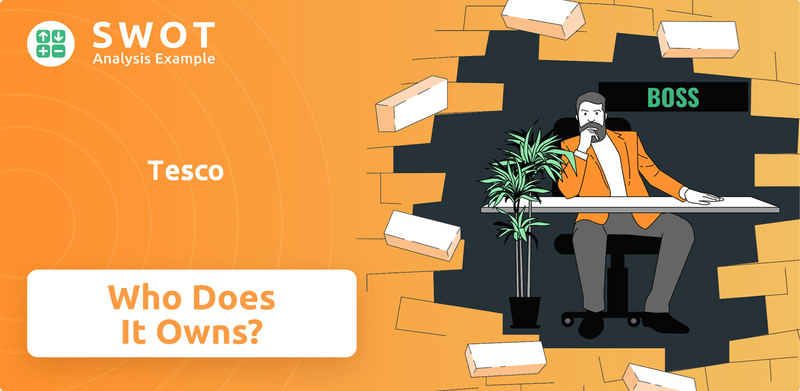
From its humble beginnings in 1919, founded by Jack Cohen, Tesco has evolved into a retail giant. The Tesco parent company structure, including its public shareholders and the influence of the Tesco CEO, is a critical factor in understanding its current market capitalization and future prospects. This exploration will provide a comprehensive overview of the Tesco ownership structure, its history, and the impact of its major shareholders on its financial performance.
Who Founded Tesco?
The story of Tesco begins with its founder, Jack Cohen, who established the business in 1919. Starting from a market stall, Cohen built what would become one of the world's largest retailers. The evolution of its ownership structure reflects a journey from a sole proprietorship to a publicly traded company.
The name 'Tesco' itself is a blend of initials, representing T. E. Stockwell, a tea supplier, and Cohen's own initials, 'Co.' This early phase was marked by Cohen's direct control, a testament to his hands-on approach and entrepreneurial spirit. The initial growth was fueled by Cohen's hard work and a deep understanding of customer needs.
Early ownership of Tesco was firmly in the hands of Jack Cohen. As the business grew from a market stall into a chain of grocery stores, the ownership remained largely within his control. The company's expansion was financed through retained earnings and traditional bank loans, rather than significant early external investments. Cohen's vision and personal involvement were central to the company's early operations.
Initially, Jack Cohen was the sole proprietor of Tesco, building the business through his efforts. The early growth of the company was funded primarily through retained earnings and bank loans, not through external investments. This approach allowed Cohen to maintain direct control over the company's direction and operations. Understanding the Tesco history is crucial to understanding its ownership.
- Jack Cohen founded Tesco in 1919, starting with a market stall.
- The name 'Tesco' was derived in 1924.
- Early expansion was financed through retained earnings and bank loans.
- Cohen's control ensured his vision guided the company's growth.
Tesco SWOT Analysis
- Complete SWOT Breakdown
- Fully Customizable
- Editable in Excel & Word
- Professional Formatting
- Investor-Ready Format
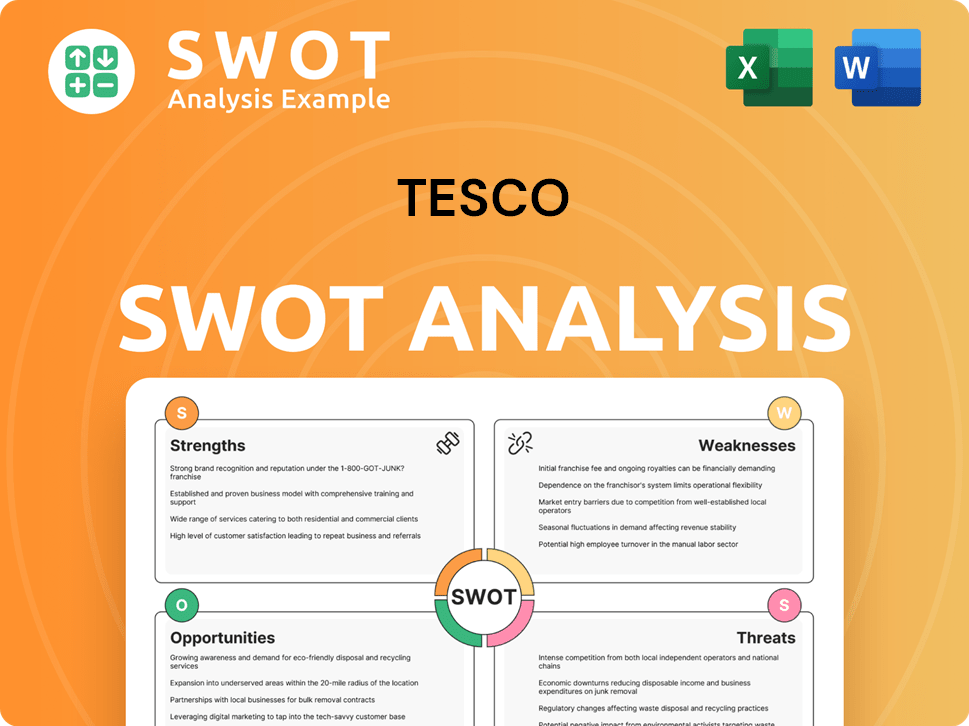
How Has Tesco’s Ownership Changed Over Time?
The journey of Tesco's ownership began with its initial public offering (IPO) in 1947, transforming it into a publicly traded entity. This pivotal moment marked a shift from family ownership to a more diversified structure, setting the stage for subsequent changes. Over the years, the ownership landscape has been shaped by market dynamics, strategic decisions, and the evolving interests of its shareholders, reflecting the company's growth and adaptation within the competitive retail sector.
The ownership structure of the company has been significantly influenced by the presence of institutional investors. These investors, managing substantial portfolios, have become key stakeholders. Their investment strategies and priorities have a direct impact on the company's strategic direction, financial performance, and governance practices. This evolution underscores the importance of understanding the influence of major shareholders in shaping the company's trajectory.
| Event | Impact on Ownership | Year |
|---|---|---|
| Initial Public Offering (IPO) | Transition from private to public ownership, broadening shareholder base | 1947 |
| Growth and Expansion | Attraction of institutional investors, increased market capitalization | Ongoing |
| Strategic Decisions | Changes in shareholding due to mergers, acquisitions, and divestitures | Various |
As of early 2025, the major shareholders of the company include prominent institutional investors like BlackRock, The Vanguard Group, and Norges Bank Investment Management. BlackRock, for example, typically holds between 3% and 5% of the shares. The Vanguard Group also maintains a significant stake, demonstrating the influence of passive investment strategies. Norges Bank Investment Management, managing Norway's sovereign wealth fund, is another key player. These large institutional investors collectively hold a substantial portion of the company's market capitalization, influencing strategic decisions and governance. The current Tesco shareholders structure highlights the significance of institutional investors in shaping the company's direction.
The company's ownership has evolved significantly since its IPO in 1947, transitioning from family control to a diverse shareholder base. The major shareholders are primarily institutional investors, including BlackRock, The Vanguard Group, and Norges Bank Investment Management.
- Institutional investors significantly influence the company's strategy and governance.
- The company's market capitalization is largely held by these large investment vehicles.
- Understanding the ownership structure is crucial for assessing the company's direction.
- The Tesco ownership structure reflects broader trends in publicly traded companies.
Tesco PESTLE Analysis
- Covers All 6 PESTLE Categories
- No Research Needed – Save Hours of Work
- Built by Experts, Trusted by Consultants
- Instant Download, Ready to Use
- 100% Editable, Fully Customizable
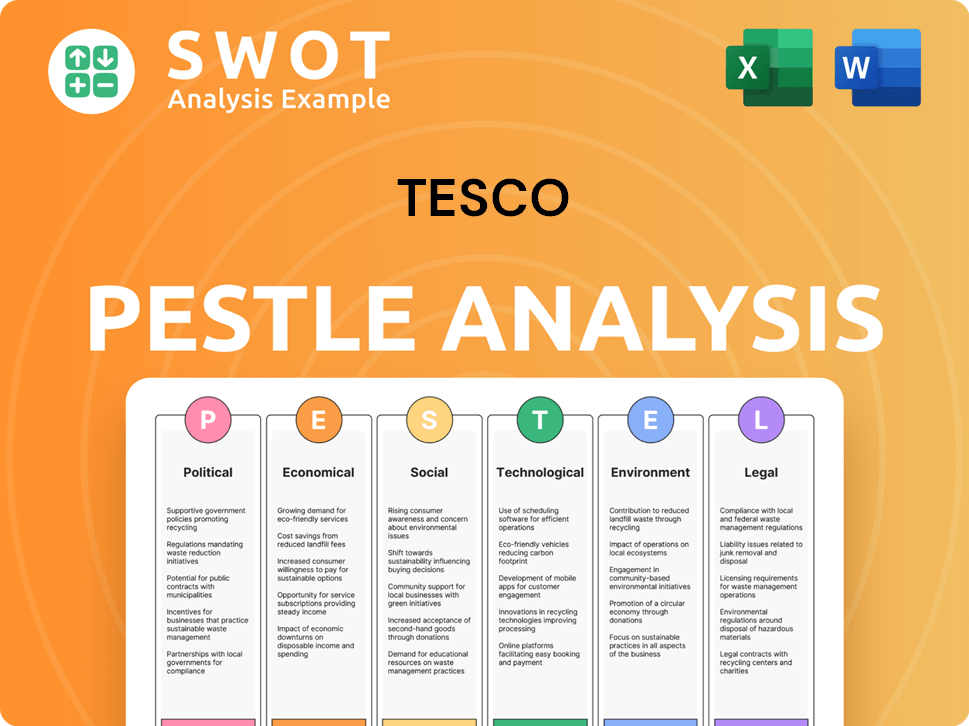
Who Sits on Tesco’s Board?
As of early 2025, the Board of Directors of the company includes a blend of executive and non-executive directors. The board typically includes the Chief Executive Officer (CEO), the Chief Financial Officer (CFO), and other executive officers. In addition, there are independent non-executive directors. The current Chairman is Gerry Murphy, and Ken Murphy serves as the Chief Executive Officer. These independent directors provide external perspectives and oversight, ensuring accountability to the shareholder base. The structure is designed to maintain robust oversight and accountability.
The board's composition reflects a commitment to good governance, with a focus on independent directors. This structure helps to ensure that the company is managed in the best interests of all shareholders. The board's role is crucial in overseeing the company's strategic direction, financial performance, and overall governance. The board's decisions are influenced by the voting power of major shareholders, who can impact resolutions like director appointments and executive compensation. For more insights, you can explore the Brief History of Tesco.
| Board Member | Position | Notes |
|---|---|---|
| Gerry Murphy | Chairman | Oversees the board's activities. |
| Ken Murphy | Chief Executive Officer | Leads the company's operations. |
| Other Non-Executive Directors | Various | Provide independent oversight and expertise. |
The relationship between the board and ownership is primarily through the representation of major shareholders and the overall governance structure. The voting structure is generally one-share-one-vote. Institutional investors like BlackRock and Vanguard influence decisions through their voting power. In early 2025, there were no prominent proxy battles or activist investor campaigns reported. The board's structure emphasizes independent non-executive directors to ensure accountability to the shareholder base. The company's market capitalization reflects its value in the market, which is influenced by its financial performance and ownership structure.
Understanding who owns Tesco involves looking at its board of directors and major shareholders. The board, composed of executive and independent non-executive directors, oversees the company's operations. Major shareholders, such as institutional investors, influence decisions through their voting power.
- The board includes the CEO, CFO, and independent directors.
- Voting is generally one-share-one-vote.
- Institutional investors have significant influence.
- The board ensures robust oversight and accountability.
Tesco Business Model Canvas
- Complete 9-Block Business Model Canvas
- Effortlessly Communicate Your Business Strategy
- Investor-Ready BMC Format
- 100% Editable and Customizable
- Clear and Structured Layout
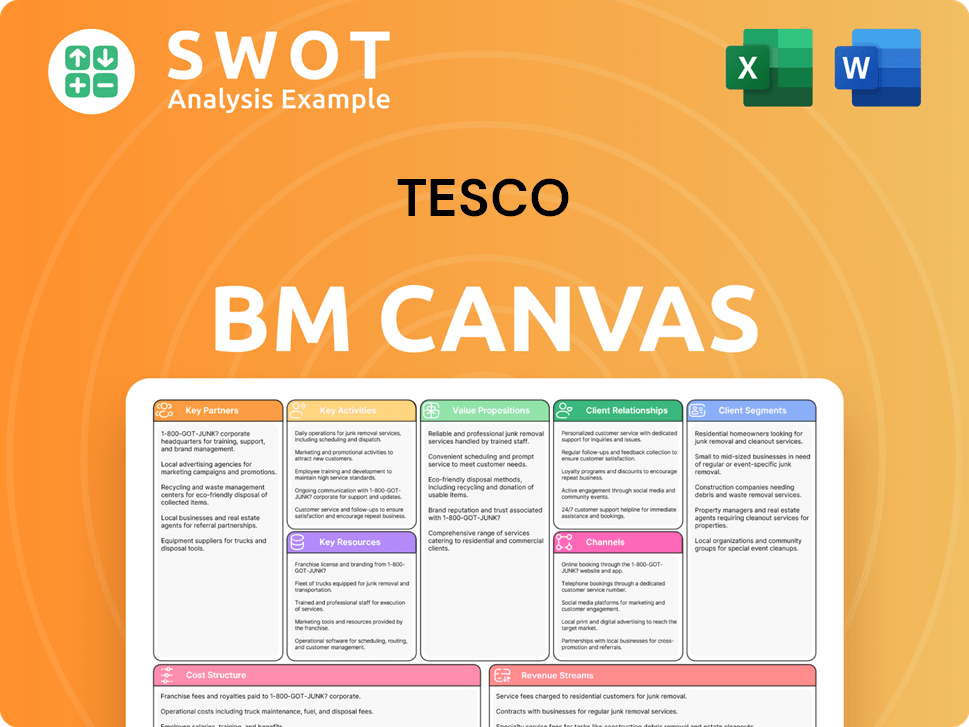
What Recent Changes Have Shaped Tesco’s Ownership Landscape?
Over the past few years, the ownership of Tesco has seen gradual shifts, primarily influenced by the dynamic nature of institutional investment. There haven't been any major changes like privatization or significant founder departures. However, the company's strategic financial actions have indirectly affected ownership. Share buybacks, for example, reduce the number of outstanding shares, increasing the percentage ownership of the remaining shareholders. In April 2024, Tesco announced a share buyback program of £1.0 billion, following a £750 million buyback the previous year. These programs aim to enhance shareholder value by returning capital and boosting earnings per share.
Industry trends often show an increased concentration of institutional ownership among large retailers like Tesco, particularly by passive index funds and large active asset managers. This trend can lead to a greater focus on ESG factors and long-term value creation from these investors. Founder dilution is a natural progression for mature public companies, as they raise capital and issue new shares over time. Consolidation within the retail sector could also lead to ownership changes through mergers and acquisitions, though Tesco has focused on organic growth and smaller strategic acquisitions recently. Understanding the Growth Strategy of Tesco is key to understanding its long-term value.
| Ownership Aspect | Details | Recent Data (2024-2025) |
|---|---|---|
| Share Buybacks | Actions to reduce outstanding shares | £1.0 billion buyback program announced in April 2024 |
| Institutional Ownership | Dominant ownership type | Increased focus on ESG and long-term value |
| Strategic Focus | Company's primary growth strategy | Organic growth and smaller strategic acquisitions |
Public statements from Tesco and analysts often focus on financial performance, dividend policy, and strategic initiatives rather than explicit discussions about future ownership changes. The current ownership structure is stable, dominated by institutional investors prioritizing sustainable growth and shareholder returns. There are no public indications of planned privatization or significant shifts in control, with the company continuing as a widely held public entity. The focus remains on enhancing shareholder value through strategic financial decisions and operational improvements.
Tesco is a publicly traded company, and its ownership is primarily held by institutional investors. The current ownership structure is stable, with no major changes expected. The company is listed on the London Stock Exchange.
The major shareholders in Tesco are primarily institutional investors, including investment firms and fund managers. These investors play a key role in influencing the company's strategic decisions. The focus is on sustainable growth and shareholder returns.
The Tesco CEO, along with the board of directors, is responsible for the company's strategic direction and financial performance. The CEO's role is crucial in maintaining shareholder value and driving the company's growth. The current CEO is focused on operational efficiency.
Tesco was founded in 1919 by Jack Cohen. Over the years, it has grown from a market stall to one of the largest retailers globally. The company has a long history of adapting to changing market conditions. It is a UK-based company.
Tesco Porter's Five Forces Analysis
- Covers All 5 Competitive Forces in Detail
- Structured for Consultants, Students, and Founders
- 100% Editable in Microsoft Word & Excel
- Instant Digital Download – Use Immediately
- Compatible with Mac & PC – Fully Unlocked
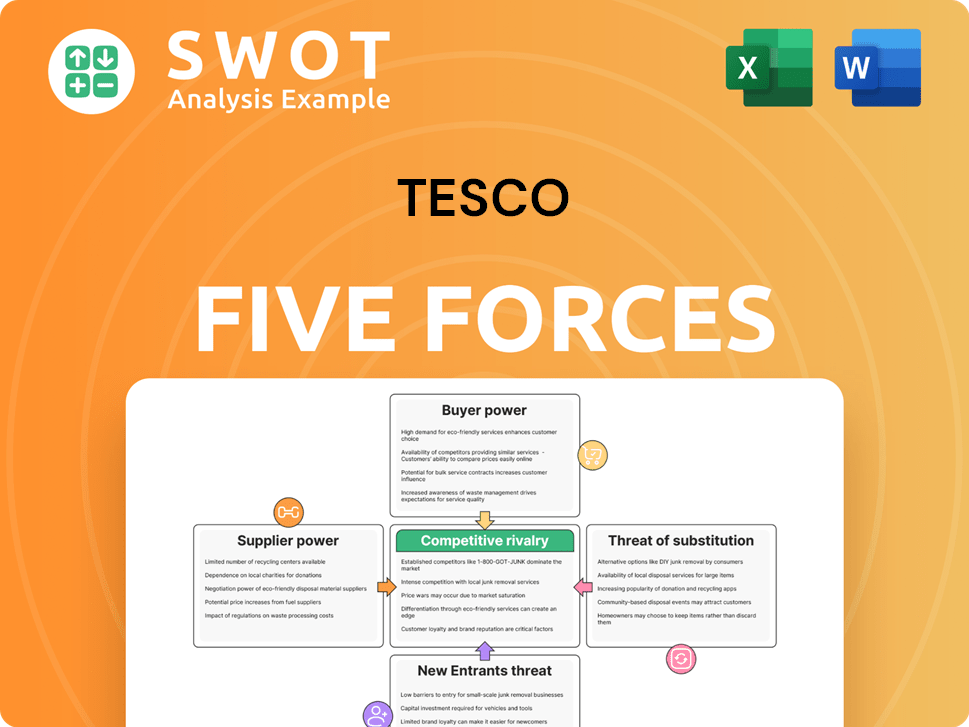
Related Blogs
- What are Mission Vision & Core Values of Tesco Company?
- What is Competitive Landscape of Tesco Company?
- What is Growth Strategy and Future Prospects of Tesco Company?
- How Does Tesco Company Work?
- What is Sales and Marketing Strategy of Tesco Company?
- What is Brief History of Tesco Company?
- What is Customer Demographics and Target Market of Tesco Company?
Disclaimer
All information, articles, and product details provided on this website are for general informational and educational purposes only. We do not claim any ownership over, nor do we intend to infringe upon, any trademarks, copyrights, logos, brand names, or other intellectual property mentioned or depicted on this site. Such intellectual property remains the property of its respective owners, and any references here are made solely for identification or informational purposes, without implying any affiliation, endorsement, or partnership.
We make no representations or warranties, express or implied, regarding the accuracy, completeness, or suitability of any content or products presented. Nothing on this website should be construed as legal, tax, investment, financial, medical, or other professional advice. In addition, no part of this site—including articles or product references—constitutes a solicitation, recommendation, endorsement, advertisement, or offer to buy or sell any securities, franchises, or other financial instruments, particularly in jurisdictions where such activity would be unlawful.
All content is of a general nature and may not address the specific circumstances of any individual or entity. It is not a substitute for professional advice or services. Any actions you take based on the information provided here are strictly at your own risk. You accept full responsibility for any decisions or outcomes arising from your use of this website and agree to release us from any liability in connection with your use of, or reliance upon, the content or products found herein.